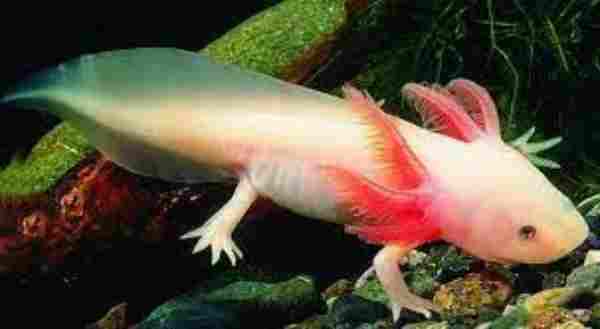Albinism is a fascinating condition that affects the production of melanin in different species, including animals and humans.
While this condition gives animals a unique and striking look, with paler skin, nose, lips, and even feathers in some birds, it also comes with some challenges and risks. Vision and hearing problems, sensitivity to the sun, and astigmatism are just some of the consequences that these creatures have to live with.
Table of Contents
But that is not the only issue: albino animals are exposed to predators and poachers looking for a rare specimen to sell. Thankfully, some of these vulnerable creatures have found a safe place in zoos and private care.
Despite the challenges, albino animals are a rare and extraordinary sight, and seeing them up close can be a once-in-a-lifetime experience.
01. Axolotl

Estimated Number in Existence: 50 – 1,000
Occurrence: N/A
Natural Habitat: Lake Xochimilco, Valley of Mexico
The axolotl is a critically endangered species listed on the IUCN Red List of Threatened Animals. Among these rare creatures, albino axolotls are even more uncommon. Though the exact number of albino axolotls is unknown, it is known that only around 1,000 individuals remain in the wild.
These unique amphibians typically come in a variety of colors, but the albino variation has captured the hearts of many as an exotic pet. Caring for albino axolotls requires a large tank and plenty of hiding places to protect their sensitive eyes from harsh lighting.
These smiling creatures love to dine on frozen blood worms and belong to the same family as salamanders, keeping their endearing juvenile traits throughout their lifecycle.
02. Turtle

Estimated Number in Existence: N/A
Occurrence: 1 in 100,000
Natural Habitat: Oceans, Seas, Lakes, Rivers
Albino turtles are considered to be a unique and rare sight, occurring only once in every 100,000 hatchlings. While the condition may appear admirable, albino turtles have lower chances of survival in the wild than their normal counterparts.
This is due to their numerous limitations, including vision problems and extreme sun sensitivity. In fact, the survival rate of albino turtles is already quite slim even without these conditions.
These rare turtles predominantly inhabit the beaches of Australia, although it is possible to spot them off the coast of Mozambique as well. Interestingly, a rare albino Indian flap shell turtle was discovered in southern India just this year, a few hours after it had hatched.
Normally, flap shell turtles boast dark brown shells with light brown spots all over their bodies.
03. Wallaby

Estimated Number in Existence: 1,000
Occurrence: 1 in 50,000
Natural Habitat: Grasslands, Forests, Woodlands of Australia
White wallabies are a rare sight in the wild, with an estimated population of less than 1,000 in Australia. These unique creatures are a subtype of wallabies that have a genetic mutation that prevents the production of melanin.
This results in their curious bright white fur, pink eyes, nose, and claws that make them distinct from their brown counterparts. Despite their stunning appearance, white wallabies have poor vision and are extremely sensitive to sunlight.
On the bright side, they do not have many predators in their habitats, and they love to huddle in groups, making them quite an adorable sight. One can find them in a few select locations, mostly on islands in Australia and Papua New Guinea.
Bruny Island in the Tasman Sea is one such place, where the white wallaby population has exceeded 200, providing a unique opportunity for visitors to witness these amazing creatures.
04. Hummingbird

Estimated Number in Existence: N/A
Occurrence: 1 in 1 million
Natural Habitat: 1 in 1 million
Albinism in birds is a rare occurrence, especially considering the large number of bird species. However, among the unique albino hummingbirds in North America is the ruby-throated hummingbird, with less than 100 of them found in North, Central, and South America.
However, distinguishing between albino and leucistic birds can be challenging because of their similar white coloration. Interestingly, albino hummingbirds have no pigmentation in their bodies, resulting in pink eyes, bills, feet, and skin, while leucistic birds can have black eyes and feet.
Despite their rarity, hummingbirds are fascinating creatures. They can migrate up to 500 miles at a time and are the only birds able to fly backward. It’s just one more reason to keep an eye out for these mesmerizing birds and appreciate how unique they are, albino or not.
05. Alligator

Estimated Number in Existence: 200
Occurrence: N/A
Natural Habitat: Freshwater, Slow-moving Rivers
Albino alligators are a stunning sight, with their pure white skin that seems to glow under the sunlight. However, this condition has its tragic consequences. Only 200 of these rare animals are left, and most of them are in private care to protect them from predators and sunlight.
Despite their striking appearance, albino alligators rarely make it to adulthood because their skin color makes them stand out and easily recognizable to predators. Additionally, their poor eyesight makes them more of an easy target.
Interestingly, the oldest and most famous albino alligator is a 23-year-old named Claude, who lives at the California Academy of Sciences in San Francisco. Claude used to have a female companion named Bonnie, but their relationship ended due to his recklessness caused by his poor eyesight.
06. Moose

Estimated Number in Existence: 50
Occurrence: 1 in 100,000
Natural Habitat: Forests of North America, Europe, Russia
The moose is one of the most majestic animals in the world. Known for their wide antlers and dark brown or black coats, these New World deer are imposing creatures. However, the rarity of the albino moose adds an extra layer to their already fascinating existence.
While some may believe that albino moose do not exist, one was spotted in Sweden, sparking controversy over their legitimacy. Some argue that these white moose are carriers of a recessive gene condition called piebald.
Regardless of their genetics, it is crucial to protect these rare creatures from those craving to kill them for their unique appearance. In 2020, a spirit moose was shot dead in Ontario, igniting a mass uproar. Thus, it is essential to preserve and respect the beauty of these magnificent animals.
07. Humpback Whale

Estimated Number in Existence: N/A
Occurrence: N/A
Natural Habitat: Great Barrier Reef
Albino humpback whales are some of the rarest albino animals that exist, making them an elusive and mysterious sight to behold. Migaloo, the most famous white whale, was first spotted in 1991 in the Great Barrier Reef and has only been seen a few times since then.
Scientists confirmed that Migaloo is a male as only male whales produce melodic songs. However, not much is known about the albino whale population, as there have only been a couple of reported sightings over the last few decades. Unfortunately, Migaloo has not been seen in over two years, and experts are worried about his health due to climate change.
Although a white whale carcass recently washed up on an Australian beach, experts confirmed that it’s not Migaloo, indicating that there are more albino whales than we know. The mystery and rarity of albino humpback whales make them a fascinating and captivating subject to learn about.
08. Kiwi

Estimated Number in Existence: N/A
Occurrence: 1 in 4
Natural Habitat: Rain forests of Southeast Asia
The kiwi bird named Manukura was a true wonder to behold. With her snowy white feathers and adorable legs, she looked like a fluffy snowball.
Despite the one in four chance of an albino kiwi bird hatching, Manukura was the only one of her kind known in the entire world. She was a true rarity, a result of being born from two parents carrying a white feather gene.
Sadly, her time on this earth was cut short, and Manukura passed away in December 2020. However, her story serves as a reminder of the unique and fascinating creatures that call New Zealand home.
Did you know that kiwi birds, despite resembling birds, have more in common with mammals? Females even have two ovaries and whiskers, much like cats. Truly, Manukura was a special and unforgettable creature.
09. Orangutan

Estimated Number in Existence: 1
Occurrence: N/A
Natural Habitat: Rainforests of Southeast Asia
Alba is a remarkable albino orangutan, the only known one in the world. She was rescued by the Borneo Orangutan Survival Foundation in 2017, having been kept as a pet in captivity. Despite being about five years old at the time of her rescue, Alba was the only living example of an albino monkey.
After receiving a year of medical treatment and close monitoring, Alba was released back into the wild. Due to her limited vision and unique white skin, she is under constant care and protection from poachers and other animals.
Today, Alba is living in a lush rainforest alongside other rehabilitated orangutans. It is important to remember that orangutans can only survive naturally in the rainforests of Borneo and Sumatra, and unfortunately, their populations are at risk, with only about 41,000 Bornean and 7,500 Sumatran orangutans left in the wild.
10. Panda

In China, giant pandas are a beloved national treasure. Their cute faces and playful demeanor have captured the hearts of people around the world. These majestic creatures primarily reside in the southwest, where they have adapted to survive almost entirely on bamboo.
Unfortunately, the wild panda population has been in decline for years, with only around 1,864 remaining in the world. Thankfully, in 2017, conservation efforts began to show promise as the population began to rebound.
This progress is a testament to the tireless work of the Chinese government, nature reserve staff, and organizations like the WWF. Although pandas are no longer classified as endangered, their long-term survival is still in question.
FAQs
What are the rarest albino animals?
While albino animals can be found across different species, some are rarer than others. Among the rarest albino animals are the white humpback whale, the white lion, the white giraffe, the white alligator, and the white moose. These animals are not only breathtakingly beautiful but also highly coveted by collectors and animal enthusiasts around the world.
How rare is it to find an albino animal?
In general, estimates suggest that less than 1% of animal populations are albino. However, certain species, such as white-tailed deer and American alligators, have higher rates of albinism. Despite their rarity, albino animals have captured the imagination of humans for centuries. They are often viewed as symbols of purity, beauty, and even magical powers.
Why are wild albino animals rare?
The answer lies within their genetics; these animals inherit a particular gene that decreases melanin production in their skin, eyes, and hair. This genetic mutation reduces their camouflage effectiveness, making them prime targets for predators in the wild. As a result, many albino animals have a reduced life expectancy, placing them in a dangerous situation and making them even rarer to find.
Final Words
Albinism might be considered rare among animals, but there are a few out there that are even rarer, albino animals. These creatures look unique and breathtaking with their white fur and red eyes. From the white lion to the white humpback whale, these albino animals are a sight to behold. Not only are they beautiful, but their rarity just adds to the level of fascination people have with them. Sadly, albino animals also face numerous obstacles in nature, such as increased vulnerability to predators and difficulty finding food due to reduced camouflage.
Reference:
- https://www.indiatimes.com/trending/environment/15-rare-albino-animals-541190.html
- https://tpwd.texas.gov/publications/nonpwdpubs/young_naturalist/animals/albinos/index.phtml
- https://rarest.org/animals/rarest-albino-animals

Jeevan Kodiyan
An animal enthusiast with an interest in zoology, studying the behavior and activities of animals in the wild habitat. I work on research projects related to species conservation and endangered species protection. I also leverage zoology to become an educator, educating others about the importance of protecting our natural environment and the beauty of animals in their natural habitats.









